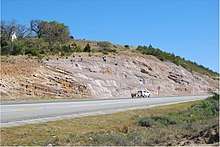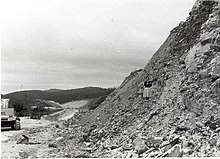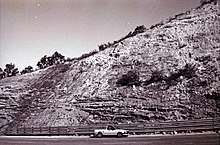Waterloo Farm lagerstätte
The Waterloo Farm lagerstätte in South Africa is a unique fossil site which preserves a wide range of 360 million-year-old plant, invertebrate and vertebrate fossils from a high-latitudinal Gondwanan setting. Collectively they provide a holistic record of a Famennian (Latest Devonian) estuarine ecosystem. The fossils are preserved as flattened silvery-white impressions in black shale.[1]

Witpoort Formation black shales within the Eastern Cape often exhibit cyclical changes in composition, which likely reflect (potentially seasonal) fluctuations in water salinity. Water stratification within the estuarine lake frequently led to anoxic bottom waters, resulting in episodes of exceptional preservation.[2]
Witpoort Formation sediments were deeply buried due to continued basinal subsidence through the Carboniferous, and were subsequently metamorphosed during the massive Permian aged Cape Fold Belt orogenesis.[3] Hundreds of millions of years of erosion and uplift brought the Waterloo Farm shales back up to near surface, they were exposed in 1985, in new road cuttings south of Makhanda/Grahamstown, during construction of a bypass road.

On-site excavations were conducted in the 1990s, but the instability of the road cutting led to it being cut back in 1999 and in 2008. On both occasions large quantities of shale were rescued which provides for ongoing excavation. Decades of research has revealed the most important Late Devonian fossil site from what was the southern portion of Gondwana -a region incorporating present-day sub-saharan Africa, South America and western Antarctica.[4]



Because the original fine black mud was often very low in oxygen, plants and animals rapidly buried in it sometimes left behind impressions of their soft parts. This is extremely rare in the fossil record which normally only preserves bones, teeth and other hard bits. Exceptionally, what is recorded is the remains of an entire estuarine ecosystem, from delicate waterweeds and seaweeds to small clams, baby fish and the bones of larger fish. Land plants which grew nearby are also preserved, from the remains of small undergrowth species to fronds from the earliest types of trees.[5]
More than 20 species new to science have been named from Waterloo Farm, which probably represent about a third of the total number of taxa indicated by remains preserved in the shale. Taxa include the tetrapods Tutusius umlambo and Umzantsia amazana,[6] which are Africa's earliest known tetrapods and the only non-tropical Devonian tetrapods known. The first described fossils from Waterloo Farm comprise remains of sub-Saharan Africa's earliest woody trees (Archaeopteris notosaria).
_twigs_and_leaves.jpg)
.[7] Other fossils from Waterloo Farm include the oldest known land-living animal from Gondwana (the scorpion Gondwanascorpio emzantsiensis),[8] the oldest fossil lamprey in the world (Priscomyzon riniensis)[9] and Africa's oldest coelacanth from the world's earliest known coelacanth nursery (Serenichthys kowiensis).[10]
Other species represented include several species of armour plated (placoderm) fish, spiny finned (acanthodian) fish, sharks, ray-finned (actinopterygian) fish, a range of lobe-finned fish, bivalves; seaweeds; charophyte waterweeds, and a diverse range of plants.
List of published taxa from Waterloo Farm
Animalia
Invertebrates
Mollusca, Bivalvia
Naiadites form Devonica[11]
Arthropoda
Eurypterida
Cyrtoctenid eurypterid indet.[5]
Arachnida, Scorpiones
Gondwanascorpio emzantsiensis[8]
Vertebrata
Agnatha
Priscomyzon riniensis[9]
Placodermi
Bothriolepis africana[12]
Groenlandaspis riniensis[12]
Africanaspis edmountaini[13]
Gen. et sp. indet.
Actinopterygii
gen. et. sp. indet.
Sarcopterygii
Serenichthys kowiensis[10]
Rhizodont indet.[5]
Isityumzi mlomomde (gen. et sp. nov.) [17]
Plantae
Algae
Charophyta
Hexachara setacea (gen. et sp. nov.)[22][23]
Hexachara riniensis (gen. et sp. nov.)[24][25]
Tracheophyta
Zosterophyllopsida
Zosterophyll indet.[30]
Iridopteridales
Iridopterlean indet[5]
Sphenopsida
Rinistachya hilleri[33]
Progymnospermopsida
Archaeopteris notosaria[7]
References
- Gess, Robert Wolfgang (14 May 2012). High latitude Gondwanan Famennian biodiversity patterns: evidence from the South African Witpoort Formation (Cape Supergroup, Witteberg Group) (Report). hdl:10539/11467.
- Gess, Robert W. (2016). "Vertebrate Biostratigraphy of the Witteberg Group and the Devonian-Carboniferous Boundary in South Africa". Origin and Evolution of the Cape Mountains and Karoo Basin. Regional Geology Reviews. pp. 131–140. doi:10.1007/978-3-319-40859-0_13. ISBN 978-3-319-40858-3.
- Blewett, Scarlett C. J.; Phillips, David (2016). "An Overview of Cape Fold Belt Geochronology: Implications for Sediment Provenance and the Timing of Orogenesis". Origin and Evolution of the Cape Mountains and Karoo Basin. Regional Geology Reviews. pp. 45–55. doi:10.1007/978-3-319-40859-0_5. ISBN 978-3-319-40858-3.
- Coates, Michael I.; Gess, Robert W. (2007). "A New Reconstruction of Onychoselache Traquairi, Comments on Early Chondrichthyan Pectoral Girdles and Hybodontiform Phylogeny". Palaeontology. 50 (6): 1421–1446. doi:10.1111/j.1475-4983.2007.00719.x.
- Gess, Robert W.; Whitfield, Alan K. (14 February 2020). "Estuarine fish and tetrapod evolution: insights from a Late Devonian (Famennian) Gondwanan estuarine lake and a southern African Holocene equivalent". Biological Reviews. doi:10.1111/brv.12590. PMID 32059074.
- Gess, Robert; Ahlberg, Per Erik (8 June 2018). "A tetrapod fauna from within the Devonian Antarctic Circle". Science. 360 (6393): 1120–1124. Bibcode:2018Sci...360.1120G. doi:10.1126/science.aaq1645. PMID 29880689.
- Anderson, Heidi M.; Hiller, Norton; Gess, Robert W. (1 April 1995). "Archaeopteris(Progymnospermopsida) from the Devonian of southern Africa". Botanical Journal of the Linnean Society. 117 (4): 305–320. doi:10.1006/bojl.1995.0021.
- Gess, Robert W. (December 2013). "The Earliest Record of Terrestrial Animals in Gondwana: A Scorpion from the Famennian (Late Devonian) Witpoort Formation of South Africa". African Invertebrates. 54 (2): 373–379. doi:10.5733/afin.054.0206.
- Gess, Robert W.; Coates, Michael I.; Rubidge, Bruce S. (October 2006). "A lamprey from the Devonian period of South Africa". Nature. 443 (7114): 981–984. Bibcode:2006Natur.443..981G. doi:10.1038/nature05150. PMID 17066033.
- Gess, Robert W.; Coates, Michael I. (1 October 2015). "Fossil juvenile coelacanths from the Devonian of South Africa shed light on the order of character acquisition in actinistians". Zoological Journal of the Linnean Society. 175 (2): 360–383. doi:10.1111/zoj.12276.
- Scholze, Frank; Gess, Robert W. (1 April 2017). "Oldest known naiaditid bivalve from the high-latitude Late Devonian (Famennian) of South Africa offers clues to survival strategies following the Hangenberg mass extinction". Palaeogeography, Palaeoclimatology, Palaeoecology. 471: 31–39. Bibcode:2017PPP...471...31S. doi:10.1016/j.palaeo.2017.01.018.
- Long, J. A.; Anderson, M. E.; Gess, R.; Hiller, N. (19 June 1997). "New placoderm fishes from the Late Devonian of South Africa". Journal of Vertebrate Paleontology. 17 (2): 253–268. doi:10.1080/02724634.1997.10010973.
- Gess, Robert W.; Trinajstic, Kate M.; Smith, Thierry (5 April 2017). "New morphological information on, and species of placoderm fish Africanaspis (Arthrodira, Placodermi) from the Late Devonian of South Africa". PLOS One. 12 (4): e0173169. Bibcode:2017PLoSO..1273169G. doi:10.1371/journal.pone.0173169. PMC 5381866. PMID 28379973.
- Anderson, M. Eric; Long, John A.; Gess, Robert W.; Hiller, Norton (1999). "An unusual new fossil shark (Pisces: Chondrichthyes) from the Late Devonian of South Africa". Records of the Western Australian Museum. 57: 151–156.
- Daeschler, Edward B.; Downs, Jason P. (May 2018). "New description and diagnosis of Hyneria lindae (Sarcopterygii, Tristichopteridae) from the Upper Devonian Catskill Formation in Pennsylvania, U.S.A.". Journal of Vertebrate Paleontology. 38 (3): e1448834. doi:10.1080/02724634.2018.1448834.
- https://pdfs.semanticscholar.org/2040/80f70338d067837ec2d44f92bb47288d799a.pdf
- https://onlinelibrary.wiley.com/doi/abs/10.1111/brv.12590
- Gess, Robert W. (1995). "A Preliminary Catalogue of Fossil Algal, Plant, Arthropod, and Fish Remains from a Late Devonian Black Shale Near Grahamstown, South Africa".
- Gess, Robert W.; Whitfield, Alan K. (2020). "Estuarine fish and tetrapod evolution: Insights from a Late Devonian (Famennian) Gondwanan estuarine lake and a southern African Holocene equivalent". Biological Reviews. doi:10.1111/brv.12590. PMID 32059074.
- Gess, Robert W. (1995). "A Preliminary Catalogue of Fossil Algal, Plant, Arthropod, and Fish Remains from a Late Devonian Black Shale Near Grahamstown, South Africa".
- Gess, Robert W.; Whitfield, Alan K. (2020). "Estuarine fish and tetrapod evolution: Insights from a Late Devonian (Famennian) Gondwanan estuarine lake and a southern African Holocene equivalent". Biological Reviews. doi:10.1111/brv.12590. PMID 32059074.
- Gess, R.W.; Hiller, N. (1995). "Late Devonian charophytes from the Witteberg Group, South Africa". Review of Palaeobotany and Palynology. 89 (3–4): 417–428. doi:10.1016/0034-6667(95)00007-8.
- Gess, Robert W.; Whitfield, Alan K. (2020). "Estuarine fish and tetrapod evolution: Insights from a Late Devonian (Famennian) Gondwanan estuarine lake and a southern African Holocene equivalent". Biological Reviews. doi:10.1111/brv.12590. PMID 32059074.
- Gess, R.W.; Hiller, N. (1995). "Late Devonian charophytes from the Witteberg Group, South Africa". Review of Palaeobotany and Palynology. 89 (3–4): 417–428. doi:10.1016/0034-6667(95)00007-8.
- Gess, Robert W.; Whitfield, Alan K. (2020). "Estuarine fish and tetrapod evolution: Insights from a Late Devonian (Famennian) Gondwanan estuarine lake and a southern African Holocene equivalent". Biological Reviews. doi:10.1111/brv.12590. PMID 32059074.
- Gess, R.W.; Hiller, N. (1995). "Late Devonian charophytes from the Witteberg Group, South Africa". Review of Palaeobotany and Palynology. 89 (3–4): 417–428. doi:10.1016/0034-6667(95)00007-8.
- Gess, Robert W.; Whitfield, Alan K. (2020). "Estuarine fish and tetrapod evolution: Insights from a Late Devonian (Famennian) Gondwanan estuarine lake and a southern African Holocene equivalent". Biological Reviews. doi:10.1111/brv.12590. PMID 32059074.
- Gess, R.W.; Hiller, N. (1995). "Late Devonian charophytes from the Witteberg Group, South Africa". Review of Palaeobotany and Palynology. 89 (3–4): 417–428. doi:10.1016/0034-6667(95)00007-8.
- Gess, Robert W.; Whitfield, Alan K. (2020). "Estuarine fish and tetrapod evolution: Insights from a Late Devonian (Famennian) Gondwanan estuarine lake and a southern African Holocene equivalent". Biological Reviews. doi:10.1111/brv.12590. PMID 32059074.
- Gess, R. W.; Hiller, N. (1 December 1995). "Late Devonian charophytes from the Witteberg Group, South Africa". Review of Palaeobotany and Palynology. 89 (3): 417–428. doi:10.1016/0034-6667(95)00007-8.
- Prestianni, C.; Gess, R. W. (1 October 2014). "The rooting system of Leptophloeum Dawson: New material from the Upper Devonian, Famennian Witpoort Formation of South Africa". Review of Palaeobotany and Palynology. 209: 35–40. doi:10.1016/j.revpalbo.2014.05.007.
- Gess, R. W.; Prestianni, C. (1 February 2018). "Kowieria alveoformis gen. nov. sp. nov., a new heterosporous lycophyte from the Latest Devonian of Southern Africa". Review of Palaeobotany and Palynology. 249: 1–8. doi:10.1016/j.revpalbo.2017.10.002.
- Prestianni, Cyrille; Gess, Robert W. (28 November 2018). "Rinistachya hilleri gen. et sp. nov. (Sphenophyllales), from the upper Devonian of South Africa". Organisms Diversity & Evolution. 19 (1): 1–11. doi:10.1007/s13127-018-0385-3.